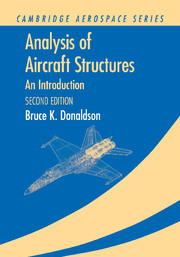Book contents
- Frontmatter
- Contents
- Introduction to the Second Edition
- Introduction to the First Edition
- List of Repeated Engineering Symbols
- Acknowledgments
- Part I The Fundamentals of Structural Analysis
- Part II **Introduction to the Theory of Elasticity**
- Part III Engineering Theory for Straight, Long Beams
- 9 Bending and Extensional Stresses in Beams
- 10 Beam Bending and Extensional Deflections
- 11 Additional Beam Bending Topics
- 12 Uniform Torsion of Beams
- 13 Beam Torsion Approximate Solutions
- Beam Bending and Torsion Review Questions
- 14 Beam Shearing Stresses Due to Shearing Forces
- Part IV Work and Energy Principles
- Part V Energy-Based Numerical Solutions
- Part VI Thin Plate Theory and Structural Stability
- Appendix A Additional Topics
- Appendix B Selected Answers to Exercises
- References
- Index
9 - Bending and Extensional Stresses in Beams
from Part III - Engineering Theory for Straight, Long Beams
Published online by Cambridge University Press: 05 June 2012
- Frontmatter
- Contents
- Introduction to the Second Edition
- Introduction to the First Edition
- List of Repeated Engineering Symbols
- Acknowledgments
- Part I The Fundamentals of Structural Analysis
- Part II **Introduction to the Theory of Elasticity**
- Part III Engineering Theory for Straight, Long Beams
- 9 Bending and Extensional Stresses in Beams
- 10 Beam Bending and Extensional Deflections
- 11 Additional Beam Bending Topics
- 12 Uniform Torsion of Beams
- 13 Beam Torsion Approximate Solutions
- Beam Bending and Torsion Review Questions
- 14 Beam Shearing Stresses Due to Shearing Forces
- Part IV Work and Energy Principles
- Part V Energy-Based Numerical Solutions
- Part VI Thin Plate Theory and Structural Stability
- Appendix A Additional Topics
- Appendix B Selected Answers to Exercises
- References
- Index
Summary
Introduction
The theory of elasticity problems of Chapters 7 and 8 are restricted to plane stress problems. In most of those illustrative problems the elastic body has a simple geometry that is either a circular disk or a straight beam with a uniform, rectangular cross-section. In each of those example problems the loadings and material properties are also chosen to be mathematically simple. While there are many theory of elasticity solutions much more complex than those illustrated in Chapters 7 and 8, it may generally be said that almost all theory of elasticity solutions involve relatively simple geometries, simple material descriptions, and simple loadings. For example, there are no theory of elasticity solutions for straight beams with any of the efficient cross-sectional geometries usually used in engineering, such as I- or H-shaped cross-sections. Thus it is quite rare that a theory of elasticity solution is, in any precise sense, directly applicable to an everyday engineering problem. Nevertheless, the theory of elasticity problem is the problem to be solved in one manner or another.
One possible approach to actual engineering problems involving the common components (often called “elements”) of vehicular structures such as bars or beams, and plates or shells, is to seek what is called a numerical solution to all four sets of equations that comprise the theory of elasticity rather than seek an analytical solution. The solutions of Chapters 7 and 8 exemplify analytical solutions, that is, solutions expressed in terms of mathematically smooth functions.
- Type
- Chapter
- Information
- Analysis of Aircraft StructuresAn Introduction, pp. 225 - 270Publisher: Cambridge University PressPrint publication year: 2008



